Foxconn Delivers for Apple
The Foxconn Factory Video Tour
About The Video
This video is not the ideal factory tour. It was primarily used as background for a narrative on Foxconn's labor situation. As such, it emphasizes those areas with many employees such as final assembly and packaging. It shows few scenes from board fab and other areas. The editing jumps quickly from scene to scene for dramatic effect and makes it difficult to discern operational details. Some of our conclusions come from frame-by-frame analysis which reveals more than a simple observation of the video.
Alternate Video Report
This short video shows some additional scenes at Foxconn. It is a much more impartial report about labor conditions and people than the Nightline report.
Key Features
Lines
One of the most striking features is the use of long assembly lines with little automation and very short work times. This is very similar to Henry Ford's approach of 90 years ago and for many of the same reasons (See Photo).
Foxconn, like Ford, uses unskilled labor and the migrant nature of this labor makes for considerable turnover. Short cycle times and repetitive tasks mean that individuals can learn a particular task quickly and are interchangeable.
China's Manufacturing Environment
Capital for investment in sophisticated manufacturing equipment has been in very short supply in the past. On my first trip to China in the 1980's a Chinese official offered to barter our training for rugs, tools or weapons. That situation has changed but capital remains expensive compared to labor.
Chairman Mao was a schoolteacher before he was a revolutionary. While in power he emphasized universal education and that emphasis continues to this day. China now has a literacy rate of 92% overall and 99% in the younger population.
This has provided a huge pool of young, unskilled, inexperienced but teachable labor. In addition, China is growing a large cadre of technical graduates from trade schools and junior colleges.
Most line workers are young people from China's western provinces. They sign contracts to work for a year or so, travel to the Eastern cities and live in company dormitories. They may or may not return when their contract is over. The situation in the Western provinces is changing rapidly but for now, these provinces are agricultural and primitive. Educational policies give every Chinese child an equivalent high school education and this promotes a desire for a more rewarding life. A more rewarding life is unavailable at home, so they travel to the Eastern provinces and work for companies like Foxconn.
The work at Foxconn may include long and hard days but it is certainly better than walking behind a water buffalo from sunup to sundown.
Ford had a communications problem because most of his labor force came from dozens of different countries. Few spoke English and many could not speak their neighbor's language. China has about 130 languages and many more dialects. The line arrangement and short cycles reduces the need for communication and training.
Motivation on a line is always problematic since there is little inherent job satisfaction and little opportunity for teamwork. Motivation is enforced through work standards and line speed in these situations.
Automation
Since their labor is inexpensive and capital is probably in short supply (see below), automation at Foxconn is limited. Foxconn uses automation to compensate for unskilled and/or inexperienced workers. Automation is not used to eliminate work that can be done manually. In the video it is seen (and heard) in testing operations and for data collection.
Foxconn probably uses automation for SMT placement because manual placement of such small components is difficult and error prone. They seem to use manual placement of through-hole components. There are several scenes showing manual soldering operations.
There is some evidence that Foxconn has been adding automation on the iPad lines. Starting a new product with primarily manual operations and then adding automation gradually is a very sensible approach. It allows them to refine and stabilize the process and it allows demand to stabilize before committing to expensive capital expenditures.
Supervision & Support
The line configuration requires considerable supervision. By counting heads in several scenes, it appears that Foxconn has about one supervisor for every four line workers. This is a high proportion compared to typical U.S. manufacturing.
The line approach and large number of manual tasks would require significant support from industrial engineering technicians for time study and line balancing. Steve Jobs stated that Apple's suppliers employed about 700,000 workers and 30,000 engineers and engineering technicians. The technicians are thus about 4% of the total workforce, a very high proportion compared to U.S. practice.
Key Manufacturing Tasks
In a previous article we identified Apple's Key Manufacturing Tasks as Flexibility, Quality and Cost in that order. With their 1984 Fremont factory, Apple failed to address the flexibility and quality tasks and this created a cost problem. Here is how Foxconn's Manufacturing Strategy addresses those three tasks.
Tim Cook, Apple's CEO, has stated that the primary reason Apple uses Foxconn and other Asian manufacturers is their flexibility for new products, design changes and volume changes. There are a number of legends at Apple about Foxconn's ability to adapt. One such legend has it that Steve Jobs demanded a glass screen on the iPhone just weeks before the product launch. Suppliers had to be found, new processes developed and lines reconfigured but it got done.
Foxconn's website defines their product as: Speed, Quality, Engineering Services, Flexibility and Monetary Cost Saving. This fits very well with Apple's Key Manufacturing Tasks.
Flexibility
The line production that Foxconn employs is not generally very good for product mix flexibility. While Toyota and some others have adapted lines to mixed model production this requires a wider range of skills and high motivation. It is doubtful that Foxconn could use their lines for mixed model production.
However, mixed model production is not necessary for Foxconn. Their lines are simple and the equipment is modular. It would be very easy to rearrange the lines and dedicate a line for each model. Some lines would be short, others longer to adapt to the model, the process and the volume.
Foxconn's lines can adjust for changing volume by simply adjusting the staffing, reconfiguring tasks and rebalancing the line. If there were significant and long-term changes in volume, the line can be re-configured fairly quickly. Foxconn's line approach is very flexible for new products. A line could probably be configured for a new product within a few weeks or a few months.
Quality
There is evidence that quality is taken seriously and proactively, particularly problems related to Electrostatic Discharge (ESD). There were no scenes in the video that showed workers handling boards or components without ESD protection. Several scenes from the video and other sources indicate very high-level ESD protection. Compare these scenes to the Fremont factory.
Cost
Foxconn's Manufacturing Strategy should allow the company to adjust to volume changes by shifting labor, space and equipment to other products if volume declines. This is probably where Apple's Fremont factory got into trouble--so much of their cost structure was in capital and overhead-- fixed rather than variable cost. And, Apple's automation prevented the use of the factory for other products.
Challenges for The Future
In the future, Foxconn will face many of the same challenges that Ford faced in the 1930's after its initial success. China will mature into a more modern society and prosperity will eventually filter down to the labor force. Wages are likely to rise and the inefficiencies of line production will overcome the advantage of low wages.
The One-Child birth control policy that China instituted in 1979 is affecting the pool of young laborers. Some of the Eastern factories are now reporting shortages of workers.
As opportunities for young workers increase, these literate young people will demand more from their jobs
than just wages and mind-numbing repetition. Such dissatisfaction will likely lead to some form of collective bargaining, higher wages and changes in working conditions that reduce flexibility and worker efficiency. If Foxconn fails to address the motivation issue, as Ford did, their factories will become less and less efficient and more and more costly to operate. Foxconn will have to address the Socio-Technical issues.
Scenes From The Video Tour
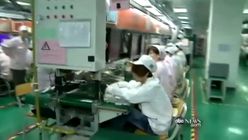
Lots of people, short-cycles, repetitive operations and simple conveyors are the most striking features at Foxconn.
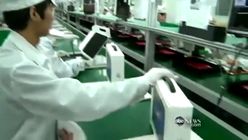
Packaging & Labeling workers using simple belt conveyor.
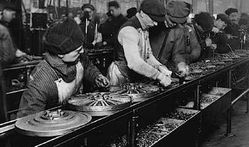
Assembly line at River Rouge complex. This is similar to Foxconn for the same reason--plentiful, unskilled and cheap labor.
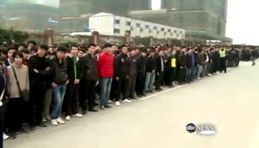
Job applicants line up at Foxconn.
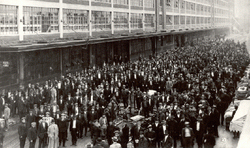
Job Applicants at Ford's Highland Park factory (1914).
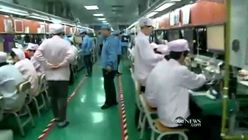
There appears to be about one supervisor for every four workers on this line. This ratio is also found in several other scenes.
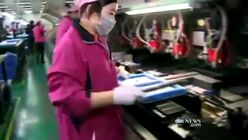
NC machining of cases. Foxconn uses automation and technology when manual skills are insufficient.
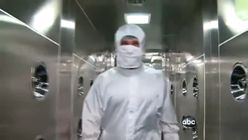
Bill Weir of ABC Nightline takes an air shower to eliminate dust particles.
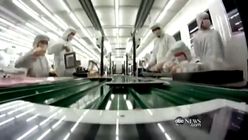
iPads move along a simple belt conveyor. Full bunny suits are required. Probably because the workers are touching unprotected circuit boards.
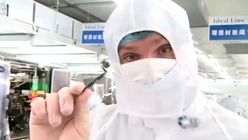
Weir displays a camera module and is apparently in a board fab area.

Manually placing components (probably the camera module) on circuit boards. Note gloves, tweezers and bunny suit.
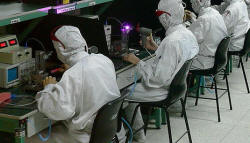
Full bunny suits and ESD grounding straps indicate an effective ESD program and a concern for quality.
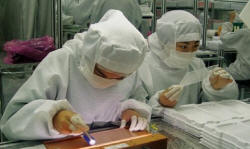
High level contamination control.
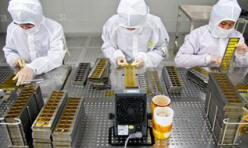
Bunny suits, gloves, ESD work surface and air ionizers for ESD protection.
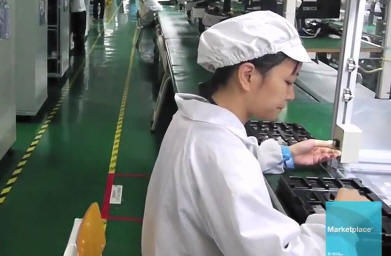
iPad motherboard assembly. Note blue grounding strap on left wrist.

Pick & Place equipment just recently installed.
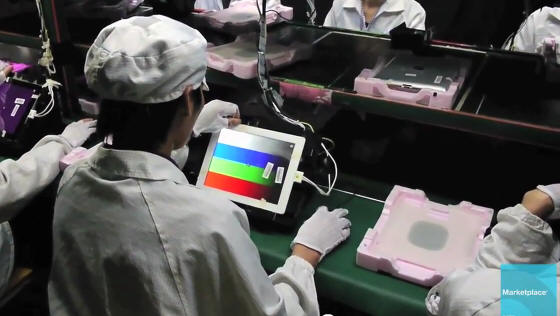
Final testing. No extended burn-in is required, probably because of the extensive ESD control and other quality control.
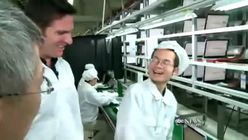
This appears to be a burn-in area. Compare to the huge burn-in tower at Fremont.
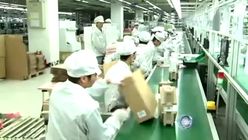
In this packaging area there is a lot of activity and little inventory. Compare to the Fremont packaging area.
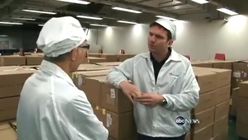
Bill Weir and Louis Woo chat in a staging area for an assembly line (immediately to the left). It is not exactly Just-In-Time but compare this to the ASRS at Fremont.
■ ■ ■ ■ ■ ■ ■


